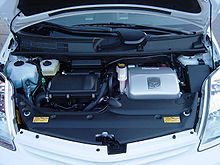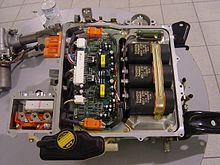Toyota Prius/2004 to 2006 model
| Toyota Prius - Contents |
|---|




The Prius 2004 model year was a complete redesign of the previous generations of Prius. The new model is based on the new (third generation) Hybrid Synergy Drive (HSD), replacing the earlier Toyota Hybrid System (THS) technology. The first generation (1997 to 2003) could not run its air conditioning unless the motor was running. In contrast, the 2004 model introduced an all-electric compressor for cooling. This allowed more extensive use of the "stealth mode" (operation on electric motor only).
The drag coefficient of 0.26 was now the second-lowest in the industry, after the smaller Honda Insight at 0.25.
Regenerative braking was greatly improved, relying so little upon the friction-type brakes (except for panic stops) that some Toyota technicians quipped that the original brake pads might well last for the life of the car.
The 2004 Prius emerged as a midsize car with more room than the previous compact, redesigned as a "five-door" model (four doors plus a rear hatch). In general the car remained conveniently narrow on the outside, rather flat sided, and relatively tall (several inches taller than a Toyota Camry). The profile was much more continuous, with a short sloping nose transitioning to a highly sloped windshield and an arcing roofline ending in a cut-off Kammback. The additional height allowed a more erect seating position and a higher eye point, giving a better view of the road to the driver. There was also a surprising amount of additional rear-seat leg room, resembling that available in a much larger vehicle. Fold down rear seats with a 60/40 split made for easy carriage of most parcels.
With a smaller and lower voltage NiMH battery and an inverter to step the voltage up to 500 V, the 2004 model was more powerful (2 seconds faster in 0 to 96 km/h acceleration) and is 15% more fuel efficiency|fuel efficient than the previous generation Prius, with 60 miles per US gallon (4.3 L/100 km) city and 50 miles per US gallon (4.7 L/100 km) highway (according to the EPA). When driven appropriately, commuting and mixed suburban drivers are reporting fuel consumption of 45 to 50 miles per US gallon (5.2 to 4.7 L/100 km). See also [1]
The multi-function-display (MFD) shows fuel consumption bars for each five minute segment of driving and this can encourage economical driving. The display also indicates instantaneous fuel consumption, which is useful for detecting when the vehicle has switched from electric-only to electric + ICE. At this time it can usually be advantageous to accelerate quickly rather than lug the vehicle, in an attempt to get to a more favorable location or speed range for electric-only mode.
A Smart Key System (SKS) option eliminates the traditional ignition key. The "smart key", which resembles a conventional keyless entry remote, has buttons to remotely lock and unlock the door, as well as trigger the alarm system. It is not necessary to use any of the buttons to utilize the SE/SS system. Approaching to within one metre of the car while in-possession of the key (even inside a pocket or purse) causes the interior dome lights to fade in (if the switches are at the DOOR position). When the person with the key in their possession touches either of the front doors, or the rear hatchback door, that door is immediately unlocked and can be opened. There are three settings in which the Smart Key System (SKS) can operate with the default being - driver's door touched, driver's door unlock only; front passenger or rear hatchback touched, all doors unlock. Once inside, the car may be started by pushing the "POWER" button with the fob still safely tucked away inside your pocket or purse). To stop the car, push the "POWER" button again. Once parked, the car can be locked by a pushing a black button on the exterior door handle. The SKS system will detect keys left inside the vehicle when powered-off, and will not allow the vehicle to be locked in this situation.
There is no conventional ignition switch which needs to be turned to start the Prius, that function having been replaced by a simple round "POWER" button on the dashboard. With the SKS models, the driver only needs to sit down inside the vehicle (with the fob in their possession), press the brake with their foot and push the "POWER" button to start the vehicle. On cars which are not equipped with SKS, the driver uses the lock/unlock buttons on the fob, and puts the remote fob into a slot in the dash to allow the car to start.
The vehicle is classified as a SULEV (Super Ultra Low Emissions Vehicle), 90% cleaner than conventional gasoline-only automobiles. It comes with an Advanced Technology Partial Zero Emission Vehicle (AT-PZEV) certification by CARB (California Air Resources Board).
As an interesting side note, an option package offered in Japan and Europe gives the Prius the ability to perform parallel and reverse parking assisted by the on-board computer — the first time such a capability has been offered on a production vehicle. Eighty percent of the Prius buyers in Japan have chosen this option. The system is not intelligent though, particularly lacking machine vision which would allow avoidance of obstructions or pedestrians, so it is very limited. [2]
When the vehicle is turned-on with the "start" button, it is ready to drive immediately in "EV" (electric vehicle) mode, before the internal combustion engine is started to heat-up the emissions control system (including the catalytic converter). The delay between starting the car and starting the internal combustion engine is approximately seven seconds. The Asian and European versions of this vehicle provide a button labelled "EV" that maintains electric vehicle mode after startup, under most low-load driving conditions. The North American model does not have the "EV" button, although the "EV" mode is still supported internally by the Prius high-voltage management computer. While some have speculated that EV mode was not included on North American models in the interest of retaining the warranted battery life of 100,000 miles (160,000 km) in the US - 150,000 miles (240,000 km) in California and several other states, engineers note that EV mode is automatically overridden when the battery requires recharging from the internal combustion engine. The Prius is designed to protect the battery from extreme discharge as well as over-charge and will utilize the engine as-necessary to maintain the optimum conditions for a long battery life. In addition to information at online discussion groups, the PRIUS+ Project offers instructions for do-it-yourselfers who wish to enable the button, and aftermarket components provider Coastal Electronic Technologies offers a kit.
Evolving from the button project, The California Cars Initiative (CalCars) converted a Prius in 2004, adding larger batteries, and private companies EDrive Systems in the United States and Amberjac Projects in the UK announced plans to sell conversion kits in 2006. CalCars initiated efforts to promote fleet purchases of plug-in hybrids to be built by automakers, and documented the emissions benefits of plug-in hybrids not only on California's clean power grid but also on the national (50% coal-fueled) power grid.
Passengers of the Prius can use their Bluetooth-enabled cellphone via the car's audio system without taking the phone out of their pocket. It is the first car released with this feature.
